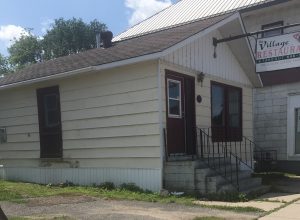
by CONNIE TABBERT
Editor
WHITEWATER REGION — Most times, a chief administrative officer isn’t impressed when a program goes over budget.
But, Whitewater Region’s Chief Administrative Officer Robert Tremblay almost seems excited when he notes that the Community Improvement Plan (CIP) is over budget by $10,000.
The CIP allows a municipal government to provide grants to property owners and tenants who are enhancing their properties.
Ginny Hoszko was one of those business owners who found out about the program, applied for it and received a grant. She noted CAO Tremblay was a big help.
“Robert Tremblay came and saw me, sat down with me, and we had a nice little meeting and he explained everything,” she recalled. “I didn’t find it that difficult at all.”
Even after filling out the application, CAO Tremblay advised she hadn’t been quite specific enough, but didn’t leave it there and helped her understand exactly what needed to be done.
“He was a great help in the whole process,” Mrs. Hoszko said. “Some of the things we were doing fell under some grant coverage and some didn’t.

“It was so amazing to get some funding from the township and even do some improvements that we would not have been able to afford ourselves.”
She believes this program has helped improve the downtown.
“I think there’s a big improvement on the main street of Cobden,” she said. “Cobden has always had a very cute little main street and I feel what some of the buildings lack in esthetics, we make up for with our personalities and friendliness. Cobden is just a cute and amazing town, I love it here.”
Mrs. Hoszko said if the opportunity arose where the program would help her again, she would apply.
CAO Tremblay recalled that when he was hired, one of the things spoken about was possibly introducing this program to the township. It was a strategy the council knew could be a way of supporting businesses and bringing economic development to the township, he said.
With funds provided through a Rural Economic Development grant through the Ontario Ministry of Agriculture, Food, and Rural Affairs last year, the CIP was created for Whitewater Region by two summer students, Masters Planning intern Robert Tran and Masters in Public Administration intern Ethan Robert.
Once the CIP was agreed to by council, which was to be in two phases – one for villages and hamlets and another for the agricultural community – it was just a matter of setting a budget and seeing if the program was something the property owners in the township would use, CAO Tremblay said.
Whitewater Region’s council knew that it needed to provide leadership in creating a downtown that people could continue to take pride in and thought of ways it could do that. The sidewalks in Westmeath and Cobden were rebuilt; Little Lakes beach was spruced up and the beach house in Cobden was renovated as well and new signage for villages and hamlets is being erected, CAO Tremblay pointed out.
Since the grants were available, there have been various businesses that have taken advantage of the program, CAO Tremblay said.
Under Phase 1, there are six grants people can apply under – accessibility improvement; building façade and property improvement; heritage property improvement; parking and landscaping improvement; planning application and building permit fee and sign improvement grant.
CAO Tremblay noted it’s not just a matter of saying you want to participate in the program, you have to provide documentation attesting to what you are doing and the funds are not released until the work is accomplished.
On May 15, 2018, the first CIP was approved for a property in Beachburg, and since then the applications have continued to come in, he said. On May 30, the Whitewater Brewery on Pembroke Street was approved for a CIP grant, followed by another grant on July 4 for the building where Main Street Spa is; August 1 for Red’s Hair Creations; Grace United Church’s CIP was approved Sept. 5 as was the CIP for the building where Caldwell Banker is located; on Sept. 19 three CIPs were approved: Studio 646 Hair Designs, Westmeath United Church and Royal LePage Team Realty; and the final CIP was approved on Nov. 7 for Helferty’s Disaster Restoration DKI.
CAO Tremblay noted the funding provided has a maximum amount and is only for a portion of the project. Explaining, he said, for building façade and property improvement, the grant is for 50 percent of the costs of construction and repairs to a maximum of $5,000; while the parking and landscaping improvement grant is also 50 percent of the costs to a maximum of $3,000.
Those asking for the grants can ask for funds from any of the six categories, he said.
The program is open to all the villages and hamlets, but so far it has mostly been used in Cobden, he said.
He noted the budget for this year’s CIP was set at $20,000, but $30,000 was approved.
“We’ll find it from other sources,” he said. “We’ll deal with it in operations or taking it from the reserves.”
He provides a yearly report to council, at which time council will then review it and see if it wants to continue with the program each year.
It’s not a program that will go on forever, he said, but so far, there is interest.
“Every year when council approves the budget, it could say this year we’ll focus on signage improvements, or support this or that,” CAO Tremblay said. “There is still lots to do, still lots of work to be done.”
Phase 2 is expected to roll out on Jan. 1, 2019 if the new council approves funding in the budget, he said.
There are also six grant categories in Phase 2: septic system improvement; cattle fencing; shoreline restoration and naturalization; agriculture buffers improvement; agriculture value-added and brownfield rehabilitation.
Again, there is a percentage of costs up to a maximum amount, he said.
If the CIP is approved by the new council, CAO Tremblay said there has to be more ways of getting the information to the property owners that there are funds available to help them with improvements.






![Kenopic/Smith Auction [Paid Ad]](https://whitewaternews.ca/wp-content/uploads/2018/10/advertising-100x75.jpeg)

